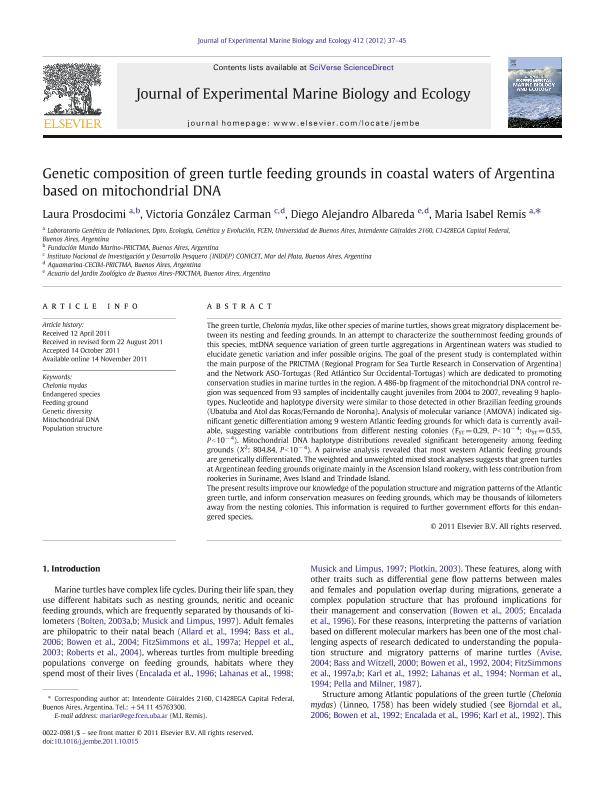Artículo
Genetic composition of green turtle feeding grounds in coastal waters of Argentina based on mitochondrial DNA
Fecha de publicación:
01/2012
Editorial:
Elsevier Science
Revista:
Journal of Experimental Marine Biology and Ecology
ISSN:
0022-0981
Idioma:
Inglés
Tipo de recurso:
Artículo publicado
Clasificación temática:
Resumen
The green turtle, Chelonia mydas, like other species of marine turtles, shows great migratory displacement between its nesting and feeding grounds. In an attempt to characterize the southernmost feeding grounds of this species, mtDNA sequence variation of green turtle aggregations in Argentinean waters was studied to elucidate genetic variation and infer possible origins. The goal of the present study is contemplated within the main purpose of the PRICTMA (Regional Program for Sea Turtle Research in Conservation of Argentina) and the Network ASO-Tortugas (Red Atlántico Sur Occidental-Tortugas) which are dedicated to promoting conservation studies in marine turtles in the region. A 486-bp fragment of the mitochondrial DNA control region was sequenced from 93 samples of incidentally caught juveniles from 2004 to 2007, revealing 9 haplotypes. Nucleotide and haplotype diversity were similar to those detected in other Brazilian feeding grounds (Ubatuba and Atol das Rocas/Fernando de Noronha). Analysis of molecular variance (AMOVA) indicated significant genetic differentiation among 9 western Atlantic feeding grounds for which data is currently available, suggesting variable contributions from different nesting colonies (F ST=0.29, P<10 -4; Φ ST=0.55, P<10 -4). Mitochondrial DNA haplotype distributions revealed significant heterogeneity among feeding grounds (X 2: 804.84, P<10 -4). A pairwise analysis revealed that most western Atlantic feeding grounds are genetically differentiated. The weighted and unweighted mixed stock analyses suggests that green turtles at Argentinean feeding grounds originate mainly in the Ascension Island rookery, with less contribution from rookeries in Suriname, Aves Island and Trindade Island.The present results improve our knowledge of the population structure and migration patterns of the Atlantic green turtle, and inform conservation measures on feeding grounds, which may be thousands of kilometers away from the nesting colonies. This information is required to further government efforts for this endangered species.
Archivos asociados
Licencia
Identificadores
Colecciones
Articulos(IEGEBA)
Articulos de INSTITUTO DE ECOLOGIA, GENETICA Y EVOLUCION DE BS. AS
Articulos de INSTITUTO DE ECOLOGIA, GENETICA Y EVOLUCION DE BS. AS
Citación
Prosdocimi, Laura; González Carman, Victoria; Albareda, Diego; Remis, Maria Isabel; Genetic composition of green turtle feeding grounds in coastal waters of Argentina based on mitochondrial DNA; Elsevier Science; Journal of Experimental Marine Biology and Ecology; 412; 1-2012; 37-45
Compartir
Altmétricas




